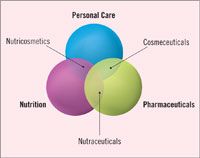CPC Ingredients - Blurring Boundaries

In the last 15 years, the pharmaceutical, personal care, and food industries have converged, giving birth to new industry segments: cosmeceuticals, nutraceuticals, and nutricosmetics. Knowing more about these markets can help smart brands take advantage of growing opportunities in these areas.
Cosmeceuticals
The cosmeceutical concept was created by Raymond Reed in 1961. During and after the late 1970s, Albert Kligman further popularized the term cosmeceutical.
Commercially, cosmeceutical products did not begin to appear on the market in earnest until the 1990s, following the success of the growing nutraceuticals industry. Cosmeceuticals are today defined by industry participants as "cosmetic products that claim to have medicinal or druglike/pharmaceutical benefits."
Of all of the personal care segments, cosmeceuticals have experienced strongest growth. This growth has been in part due to innovation and expansion of distribution channels. Once the domain of the luxury and professional sectors only, cosmeceuticals now transcend all personal care retail sectors, including direct-sales and mass-market.
The highest concentration of cosmeticeutical products is in skin care. Considering that the skin care market accounts for 30% of the total $280 billion personal care market, and that the skin care market is experiencing greatest growth (7% annual growth globally), the future looks bright for cosmeceuticals.
Innovation in cosmeceutical products is focusing on specialty actives and delivery systems. A broad range of ingredients is being used within cosmeceutical products, including botanical actives, vitamins, marine ingredients, and proteins. In the United States, sales of these specialty ingredients are valued at just over $250 million.
Along with innovative ingredients, development of delivery systems is also supporting growth of the cosmeceuticals market. Areas of innovation include smart liposomes that can reach specific target areas within the skin, and nanoparticles and microcapsules with better control-release and stabilizing technologies.
Botanicals
Botanical actives are widely used in cosmetic formulations and comprise a broad range of extracted ingredients, including bioflavanoids, polyphenols, glucosides, lipids, and antioxidants. Botanical actives have a long history of use within the personal care industry. Focus on extracting specific molecules from plant extracts is a more recent trend. For instance, manufacturers are seeking to extract catechins, such as epigallocatechin gallate from green tea; or resveratrol from grapes.
Botanical actives offer a wide range of benefits. For instance, chamomile and fennel soothe the skin, green tea has antiinflammatory properties, and primrose moisturizes. Other botanical actives sourced from materials such as grape seed and soy offer antiaging and antiwrinkle properties. The antiaging and antiwrinkle market is currently booming due to an aging population. The desire to look younger is a trend that will continue to drive growth in the active botanicals segment.

Nutricosmetics
The nutricosmetics segment emerged after the success of the growing cosmeceuticals industry and the nutraceuticals industry, which is now in excess of $120 billion in sales.
The nutricosmetics market is still in the developmental stage. Definitions for nutricosmetic vary by region. Kline & Co. defines nutricosmetics as "ingestible products containing ingredients such as botanical actives, enzymes, proteins, and vitamins that offer antioxidant benefits and that are formulated and marketed specifically as beauty aids."
Kline & Co. estimates that the combined nutricosmetic market in Europe, Japan, and the United States is $1.5 billion. However, U.S. sales of nutricosmetics (5% of the $1.5 billion) lag behind Europe's and Japan's. The nutricosmetics sold in the United States tend to focus on key issues such as antiaging, skin whitening, hair regrowth, and hair-loss management.
The current regional disparity in nutricosmetic sales is largely cultural. American consumers tend to be more interested in products that provide instant results, and therefore may tend to seek out topical products that they feel have direct results. By contrast, consumers in Japan have a long tradition in consuming beneficial foods. However, there are some U.S. nutricosmetic success stories, such as Frutels's confectionary products, which offer acne solutions, and Dove's Beautiful chocolate bars.
Currently, food, beverage, and supplement manufacturers may have an easier time finding opportunities in the nutricosmetics market, simply because they have more experience with the product format and distribution channels for ingestible products. However, for any manufacturer planning to cross the boundary into nutricosmetics, a number of factors need to be considered for success:
- The ability to support a product through the regulatory process.
- The development and promotion of a scientifically proven product.
- A user-friendly product format that is in line with the health issue being addressed.
- A communication strategy revised to accommodate specific regions and target demographics.
Anna Ibbotson is the chemicals and materials industry manager at Kline & Co. (Little Falls, NJ). Kline & Co. is a worldwide consulting and research firm dedicated to serving organizations in the chemicals, materials, energy, life sciences, and consumer products industries.

